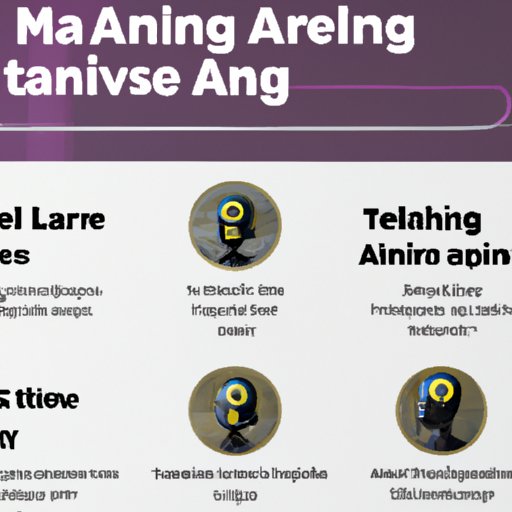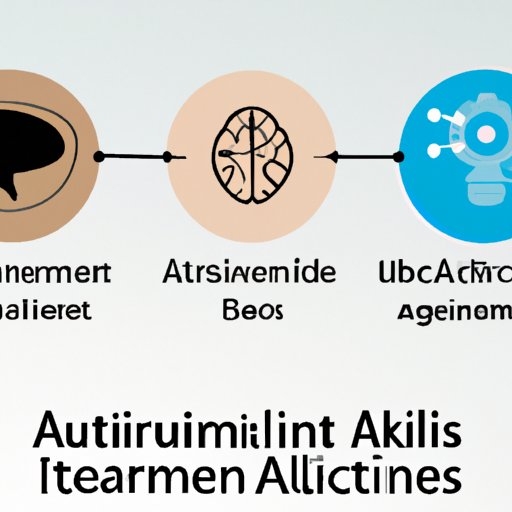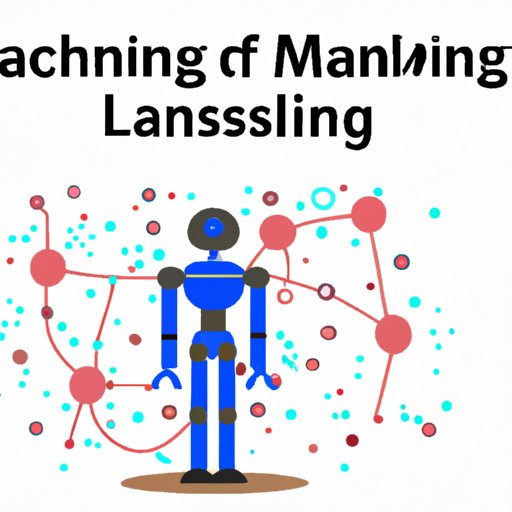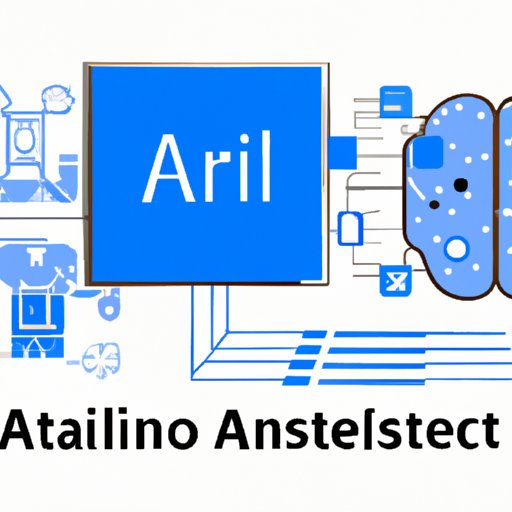Introduction
Artificial intelligence (AI) is a rapidly evolving field of computer science, with applications ranging from robotics and autonomous vehicles to natural language processing and image recognition. As AI continues to grow and become more prevalent, it’s important to understand how to get started learning the basics. This article will provide a comprehensive guide on how to begin AI learning, covering everything from identifying your learning goals to experimenting with AI projects and tutorials.
Definition of Artificial Intelligence
Before diving into the specifics of AI learning, it’s important to understand what AI is and what it can do. In simple terms, AI is a type of computer science that enables machines to “think” and make decisions in a similar way that humans do. AI is often used to automate tasks and perform complex calculations, such as analyzing large datasets or recognizing patterns in images. AI is also used in many industries, including healthcare, finance, and manufacturing, to help streamline processes and improve efficiency.

Overview of AI Learning Goals
To effectively learn AI, it’s important to first identify your learning goals. Are you looking to develop an AI application? Do you want to use AI to improve the accuracy of data analysis? Or are you simply interested in understanding the fundamentals of machine learning? Knowing what you want to achieve will help you determine which areas of AI to focus on and decide which resources are best suited for your needs.
Identifying Your AI Learning Goals
Once you have a general idea of what you want to achieve with AI, you can start to break down your learning goals into specific objectives. This will help you create a roadmap for your AI learning journey, so you know what topics to focus on and where to find the necessary resources.
Analyzing Your Needs
The first step is to analyze your AI learning needs. Take some time to think about what type of AI project you want to work on, what skills you need to acquire, and what resources are available. This process can help you identify any gaps in your knowledge and create a plan of action for filling those gaps.
Establishing Objectives
Once you’ve identified your AI learning needs, you can start to establish specific objectives. It’s important to set realistic goals that are achievable within a reasonable timeframe. For example, if you want to develop an AI application, you might set a goal to learn a specific programming language or framework within a certain period of time. Setting objectives will also help keep you motivated and track your progress.

Researching the Different Types of AI Technologies Available
Now that you have identified your AI learning objectives, it’s time to start researching the different types of AI technologies available. There are many different types of AI technologies, from neural networks and deep learning to natural language processing and computer vision. Each technology has its own pros and cons, so it’s important to do your research and understand the differences between them.
Comparing Different AI Technologies
When researching AI technologies, it’s important to compare different options and decide which one is best suited for your project. For example, if you’re working on a computer vision project, you’ll need to decide whether to use a convolutional neural network or a recurrent neural network. Understanding the differences between the various AI technologies can help you make an informed decision.

Understanding the Pros and Cons
In addition to comparing different AI technologies, it’s also important to consider the pros and cons of each option. For instance, deep learning algorithms can be computationally expensive, but they often yield better results than other algorithms. On the other hand, shallow learning algorithms are less computationally demanding but may not produce as accurate results. Evaluating the pros and cons of each AI technology can help you make an informed decision.

Understanding the Basics of Machine Learning
Machine learning (ML) is a subset of AI that focuses on developing algorithms that can learn from data and make predictions without being explicitly programmed. To effectively learn ML, it’s important to understand the fundamentals of the subject. This includes understanding the different types of algorithms used in ML, such as supervised and unsupervised learning, as well as the mathematics behind these algorithms.
The Fundamentals of ML
Before diving into ML algorithms, it’s important to understand the fundamentals of the subject. This includes understanding concepts such as linear algebra, calculus, probability, and statistics. Having a basic understanding of these topics will help you better grasp the algorithms used in ML, as well as their underlying mathematical principles.
Common Algorithms Used in Machine Learning
Once you have a basic understanding of the fundamentals of ML, you can start to explore the different algorithms used in the field. Common algorithms include decision trees, support vector machines, k-nearest neighbors, and naive Bayes. Understanding how these algorithms work and why they are used can help you gain a better understanding of ML.
Selecting a Programming Language for AI Development
Once you have a good understanding of the basics of ML and the algorithms used in the field, it’s time to start exploring programming languages for AI development. There are many different programming languages suitable for AI development, each with its own advantages and disadvantages. It’s important to do your research and select a language that is best suited for your project.
Popular Programming Languages for AI
When selecting a programming language for AI development, there are several popular options to choose from. Python is one of the most popular languages for AI development due to its ease of use and wide range of libraries and frameworks. Other popular languages for AI development include R, Java, C++, and Julia.

What to Consider When Choosing a Language
When choosing a programming language for AI development, there are several factors to consider. These include the type of project you are working on, the complexity of the algorithms you are using, and the libraries and frameworks available. Additionally, it’s important to consider the cost of the language, as some languages can be more expensive than others.
Choosing an AI Tool or Framework
Once you have selected a programming language for AI development, it’s time to choose an AI tool or framework. There are many different tools and frameworks available, such as TensorFlow, PyTorch, and Scikit-learn. Each one has its own advantages and disadvantages, so it’s important to do your research and select the best one for your project.
Types of AI Tools/Frameworks
When selecting an AI tool or framework, there are several options to choose from. Deep learning frameworks such as TensorFlow and PyTorch are popular for developing neural networks, while Scikit-learn is a popular machine learning library for Python. Additionally, there are many other tools and frameworks available, such as OpenCV for computer vision and NLTK for natural language processing.
Evaluating Different Options
Before selecting an AI tool or framework, it’s important to evaluate different options. Consider factors such as the features offered, the cost, the ease of use, and the level of support available. Additionally, it’s important to read reviews and talk to other developers to get an idea of which tools and frameworks are best suited for your project.
Experimenting with AI Projects and Tutorials
Now that you’ve identified your AI learning objectives and chosen the right tools and frameworks, it’s time to start experimenting with AI projects and tutorials. Working through tutorials and projects is an effective way to gain hands-on experience and apply your knowledge in a practical setting.
Finding Resources and Tutorials
When experimenting with AI projects and tutorials, it’s important to find reliable resources and tutorials. Popular websites such as Kaggle and GitHub offer a wide range of tutorials and projects for AI beginners. Additionally, there are many books and online courses available that can help you gain a better understanding of AI and its applications.
Working Through Examples
Once you’ve found the necessary resources and tutorials, it’s time to start working through examples. Working through examples is an effective way to gain hands-on experience and apply your knowledge in a practical setting. Additionally, it’s important to ask questions and seek help when needed, as this will help you better understand the material.
Conclusion
Starting AI learning can be daunting, but with the right resources and guidance, anyone can get started. This article provided a comprehensive guide on how to begin AI learning, covering everything from identifying your learning goals to experimenting with AI projects and tutorials. By following these steps, you can be well on your way to mastering the fundamentals of AI.
(Note: Is this article not meeting your expectations? Do you have knowledge or insights to share? Unlock new opportunities and expand your reach by joining our authors team. Click Registration to join us and share your expertise with our readers.)
